Santo António: how to celebrate Lisbon’s sardine festival
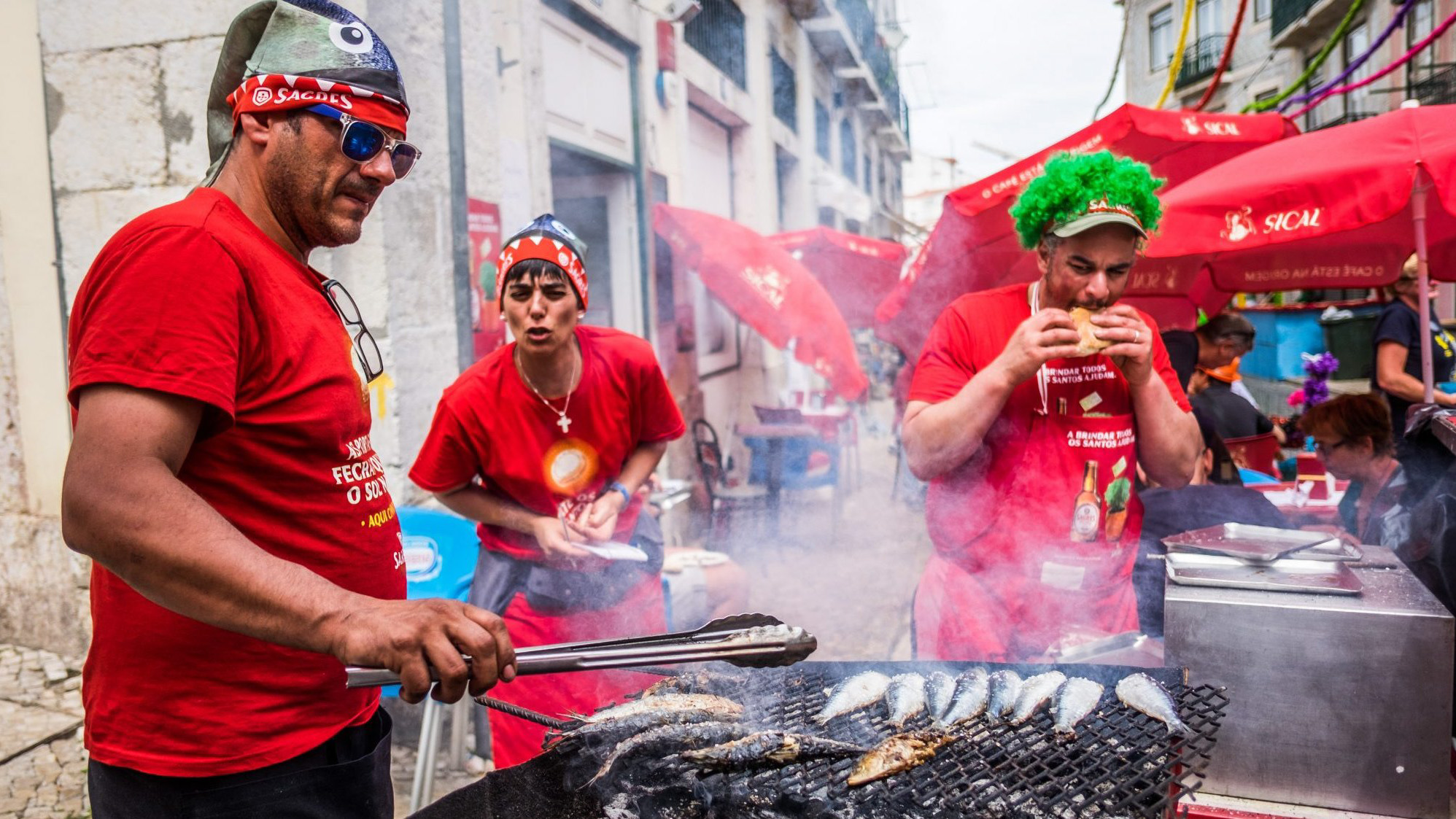
As the biggest street party in the city is dedicated to Santo António, one could immediately assume that St Anthony is Lisbon’s patron saint. That title has been reserved for St Vincent but St Anthony is Portugal’s most revered saint and he did happen to be born in Lisbon. So the date of his death, even more than eight centuries later, still works as an excuse for Lisbon to celebrate like during no other event of the year!
What are the Santos Populares festivities in Lisbon?
Celebrated every year during June, with its peak on the night of the 12th, the festival of Saint Anthony is also called Santos Populares, or popular saints, as the festivities extend during the entire month, thus covering other important dates related to St John (which is to Porto what St Anthony is to Lisbon), and St Peter.
During this month, Lisbon’s residents and visitors crowd the streets of the city’s most historic neighborhoods, such as Alfama, Castelo, Graça, Bairro Alto, Madragoa and Bica, for evenings that go well into the night, filled with music, food and drinks. You will never see Lisbon’s streets as packed as during this party, where besides make-shift stages in alleys you wouldn’t think a live concert would be possible, you’ll find improvised outdoor kitchens, smokey grills, and little bars operated by residents of these areas, often set up by their very own home’s entrance door.
Even before the party officially begins in the last days of May, going on until at least June 30th, Lisbon starts dressing up with colorful hanging decorations, as well as small pots of basil plants which are often used as table centerpieces or given as gifts to special people.
Guide to Lisbon’s June festival
So what exactly happens during St Anthony’s festival in Lisbon? A whole lot!
Marchas populares
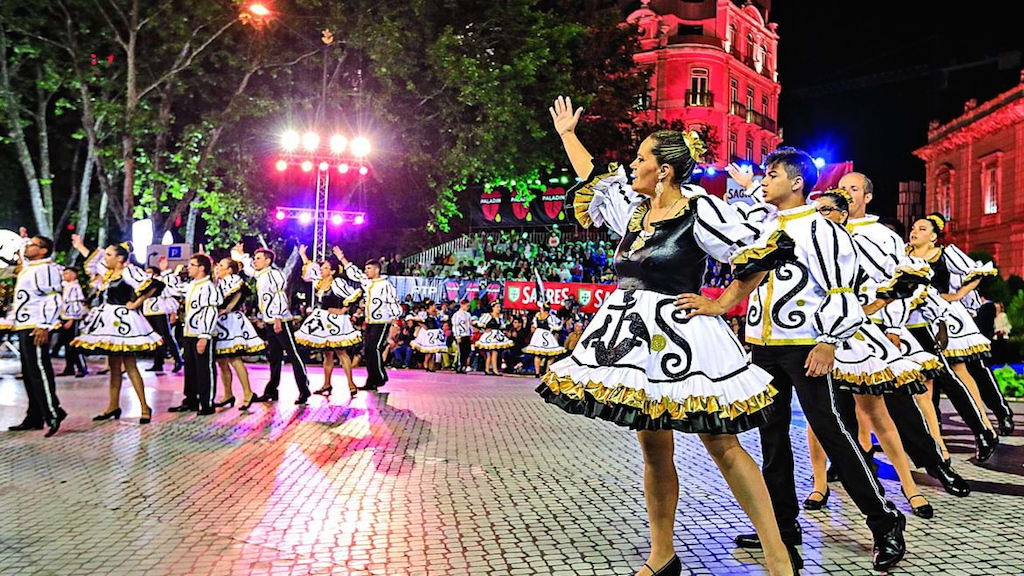 A colorful parade reminiscent of Brazil’s carnival but with less flesh on display, and in this case with representatives of each of the city’s neighborhoods, takes place down Avenida da Liberdade. This event is known as popular marches, a long established tradition dating back to the 30s. Apart from being a lively display of costumes and popular music, the marches are actually a competitive event, and that has those who are more invested into standing out carefully preparing all year long.
A colorful parade reminiscent of Brazil’s carnival but with less flesh on display, and in this case with representatives of each of the city’s neighborhoods, takes place down Avenida da Liberdade. This event is known as popular marches, a long established tradition dating back to the 30s. Apart from being a lively display of costumes and popular music, the marches are actually a competitive event, and that has those who are more invested into standing out carefully preparing all year long.
Casamentos de Santo António: mass weddings
 If you’re one of those people who has always dreamt of a grandiose wedding, you’re going to love St Anthony’s marriages. It doesn’t get more over the top than a mass wedding where sixteen couples tie the knot simultaneously. The event is organized by Lisbon’s municipality, which pays for the lucky couples to get hooked at Lisbon’s Sé Cathedral, while everything is being broadcasted live on national TV. After all, St Anthony is the patron saint of love and marriage, so we couldn’t party away without honoring his true essence.
If you’re one of those people who has always dreamt of a grandiose wedding, you’re going to love St Anthony’s marriages. It doesn’t get more over the top than a mass wedding where sixteen couples tie the knot simultaneously. The event is organized by Lisbon’s municipality, which pays for the lucky couples to get hooked at Lisbon’s Sé Cathedral, while everything is being broadcasted live on national TV. After all, St Anthony is the patron saint of love and marriage, so we couldn’t party away without honoring his true essence.
Arraiais
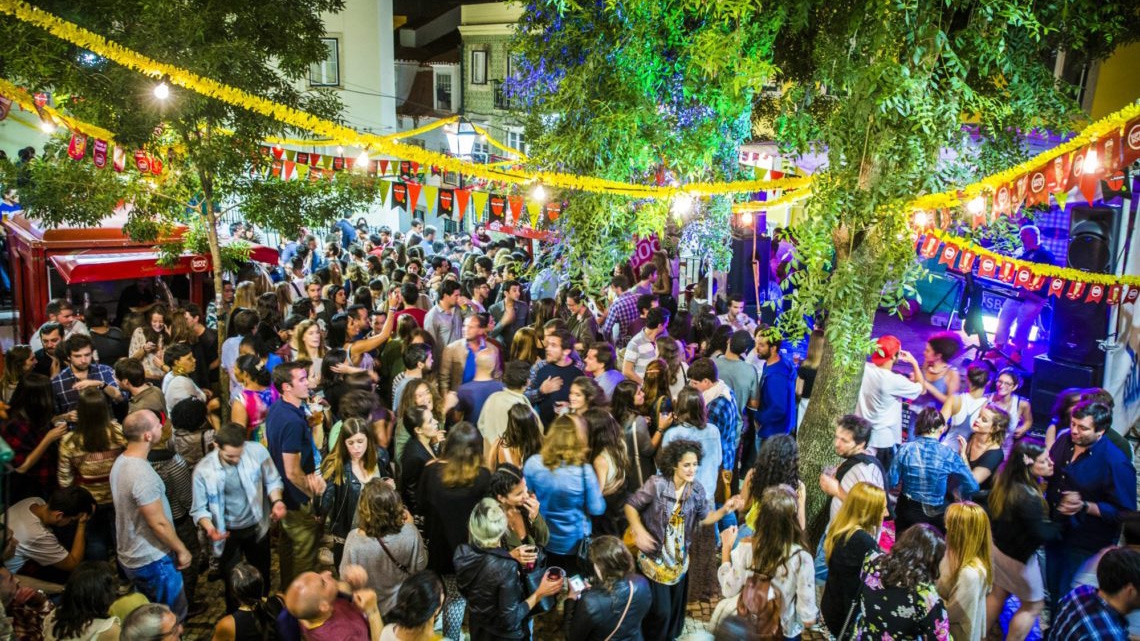 Arraial is the Portuguese word for an open air party, with popular and folksy connotations. During St Anthony’s festival in Lisbon, there are several arraiais happening simultaneously in different neighborhoods of the city, where live performances are common. Songs that are often considered corny during the rest of the year, are during these parties sung in unison, while the abundance of drinks consumed by most party-goers makes them not feel shy to dance. Lyrics are frequently naughty and innuendo charged, but no one takes offense as silliness is part of what these parties are all about.
Arraial is the Portuguese word for an open air party, with popular and folksy connotations. During St Anthony’s festival in Lisbon, there are several arraiais happening simultaneously in different neighborhoods of the city, where live performances are common. Songs that are often considered corny during the rest of the year, are during these parties sung in unison, while the abundance of drinks consumed by most party-goers makes them not feel shy to dance. Lyrics are frequently naughty and innuendo charged, but no one takes offense as silliness is part of what these parties are all about.
Alternative events during Lisbon’s popular saints festivities
 If arraiais are the most sought-after events during St Anthony and popular music will make dancers sweat like during no other time of the year, not everything is about folk music with saucy lyrics. Other concerts such as those featuring fado music or world music, will also take place in specific locations.
If arraiais are the most sought-after events during St Anthony and popular music will make dancers sweat like during no other time of the year, not everything is about folk music with saucy lyrics. Other concerts such as those featuring fado music or world music, will also take place in specific locations.
Every year, Santos Populares sees a variety of singular celebrations associated with the main festival. Arraial Lisboa Pride, the largest and most influential LGBT community event in Portugal, is organized by ILGA association in central Praça do Comércio.
Vegetarians and vegans will also be thrilled to know that, the so-called festival of sardines includes an all-vegan arraial, known by the name of Arraial Veggie Vibes, where plant based treats such as seitanas, seitan based bifanas, will fuel party goers to dance the night away.
Typical Portuguese food during St. Anthony’s celebrations
If you know anything about Portuguese culture, you’d know that, for us, celebration is synonymous with abundance of food and drinks. A proper party has traditional dishes associated with the celebrations, and the festival of Saint Anthony does of course have its very own typical bites.
Grilled sardines
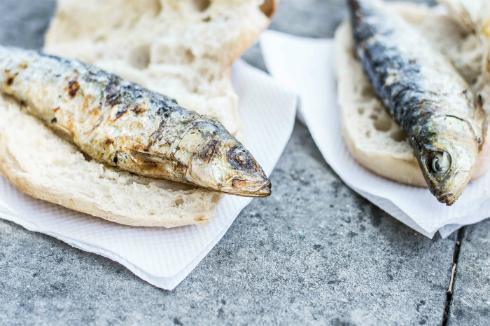 If this celebration ended up being unofficially called “the sardine festival”, it’s easy to imagine what the main food Lisbon loves eating during June is. You guessed it right: sardines! This seasonal fish is only available during warmer months, most commonly from May until the end of July. As grilled sardines are one of locals’ favorite dishes, expectations are at an all time high during June, when coming across this fresh fish is finally a given. Don’t be surprised if you feel that, during June, the most central areas of Lisbon are covered in a cloud of BBQ smoke, where the scent of sardines’ crispy skins and succulent pork mix up in the air, making it easy for you to feel peckish at any given hour.
If this celebration ended up being unofficially called “the sardine festival”, it’s easy to imagine what the main food Lisbon loves eating during June is. You guessed it right: sardines! This seasonal fish is only available during warmer months, most commonly from May until the end of July. As grilled sardines are one of locals’ favorite dishes, expectations are at an all time high during June, when coming across this fresh fish is finally a given. Don’t be surprised if you feel that, during June, the most central areas of Lisbon are covered in a cloud of BBQ smoke, where the scent of sardines’ crispy skins and succulent pork mix up in the air, making it easy for you to feel peckish at any given hour.
The most traditional way of eating sardines during the summer festivities of Lisbon is on top of a thick slice of bread, allowing you to have your food on the go. Once Lisbon’s streets are packed with people on party mode, it can be hard to get a seat whether outdoors or even at the most central restaurants. But this kind of sardine open sandwich will make it possible for you to enjoy this delicacy and waste no time. Eating a sardine atop of bread is an art form Lisbon locals have perfected over the years: first you eat the flesh around the fish’s central bone, then you turn the sardine around and repeat the same on the opposite side only leaving the head intact, and finally you enjoy the rustic bread that has by now soaked all the sardine juices and flavor. If eating directly with your mouth makes it hard to avoid small bones, make use of your fingers to pull apart the flesh. If you are lucky to get a seat at a restaurant, or even more typically, at a make-shift outdoor eatery, you may want to enjoy a serving of sardines on a plate. In this case, you’ll most likely get to eat them with a side of boiled potatoes and roasted bell peppers salad, known in Portuguese as salada de pimentos, and which consists of a cold mix of peppers previously roasted over charcoal, then marinated with olive oil, vinegar and garlic.
Pork delights: chouriço, bifanas and couratos
 If you’re not a fan of fish, there will be plenty of other traditional snacks to help you soak up the alcohol you are likely to consume during Lisbon’s street parties. The most typical meaty treats are pork based, including roasted chorizo, pão com chouriço, that is, bread buns directly baked with sliced chorizo inside, and bifanas, Portuguese pork sandwiches. While bifanas in restaurants and taverns are usually cooked in a saucy marinade of white wine and garlic, during street parties, bifanas are most commonly made with barbequed pork steaks. While usually not as juicy as those made in indoor restaurants, the smoky undertones of bifanas made in outdoor grills makes up for the lack of a more complex marinade.
If you’re not a fan of fish, there will be plenty of other traditional snacks to help you soak up the alcohol you are likely to consume during Lisbon’s street parties. The most typical meaty treats are pork based, including roasted chorizo, pão com chouriço, that is, bread buns directly baked with sliced chorizo inside, and bifanas, Portuguese pork sandwiches. While bifanas in restaurants and taverns are usually cooked in a saucy marinade of white wine and garlic, during street parties, bifanas are most commonly made with barbequed pork steaks. While usually not as juicy as those made in indoor restaurants, the smoky undertones of bifanas made in outdoor grills makes up for the lack of a more complex marinade.
Not as prevalent as bifanas or chorizo bread, sandes de courato is an old-school classic. This sandwich consists of a chunk of grilled pork skin tucked inside a bread bun, sometimes served with a squeeze of mustard. Many will agree with us that couratos are an acquired taste, but those who ask for this type of snack tend to truly love it, perhaps because of a mix of flavor and texture preferences, condimented with a sprinkle of nostalgia.
Caldo verde

While beer, wine and sangria are indeed the most consumed liquid substances during St Anthony’s festivities, typical Portuguese soup caldo verde also makes an appearance in street menus. Portugal’s potato and collard greens soup has over the decades been associated with festivities such as weddings and religious celebrations, and so St Anthony wasn’t going to be an exception.
Churros & farturas
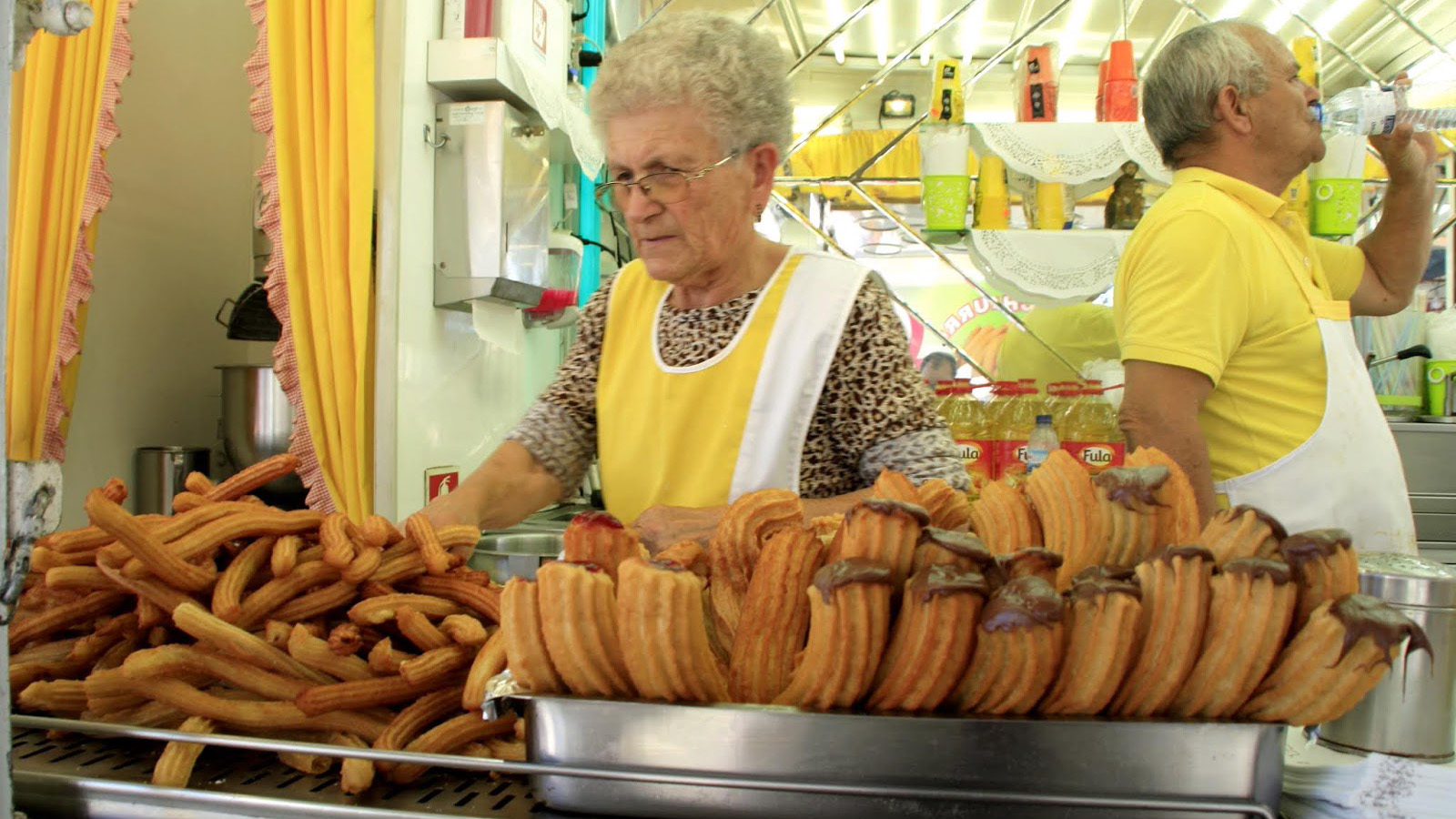 These sweet fritters aren’t specifically a St Anthony’s party snack but, instead, a must have treat during most street parties across the country. You know a street festival is about to begin when food trucks specializing in sweet fried dough park in strategic locations around town. Many will agree that fried dough eaten at a certain time of the night can do wonders to avoid hangovers, explaining while churros and farturas are popular not only with kids but also with adults. While churros consist of thin strips of doughnut, farturas are their bigger cousins, where the tubes of dough are thicker, thus making them slightly crispy on the outside but pillowy on the inside. These fritters can be eaten simply sprinkled with sugar and cinnamon, or stuffed with gooey fillings of custard, chocolate or sugary fruit jams.
These sweet fritters aren’t specifically a St Anthony’s party snack but, instead, a must have treat during most street parties across the country. You know a street festival is about to begin when food trucks specializing in sweet fried dough park in strategic locations around town. Many will agree that fried dough eaten at a certain time of the night can do wonders to avoid hangovers, explaining while churros and farturas are popular not only with kids but also with adults. While churros consist of thin strips of doughnut, farturas are their bigger cousins, where the tubes of dough are thicker, thus making them slightly crispy on the outside but pillowy on the inside. These fritters can be eaten simply sprinkled with sugar and cinnamon, or stuffed with gooey fillings of custard, chocolate or sugary fruit jams.
See the full program for Lisbon’s festivities in 2022 here.
Are you going to visit Lisbon during our most anticipated street party? If that is the case, we hope you have lots of fun and we look forward to seeing your photos celebrating and enjoying the typical foods – please tag @tasteoflisboa or use #tasteoflisboa on Instagram.
Feed your curiosity on Portuguese food culture:
When is the best time to visit Lisbon?
Itinerary for the perfect weekend in Lisbon
Day trips from Lisbon that we locals also enjoy
10 ways to enjoy Lisbon outdoors
Real people, real food. Come with us to where the locals go.
Signup for our natively curated food & cultural experiences.
Follow us for more at Instagram, Twitter e Youtube
